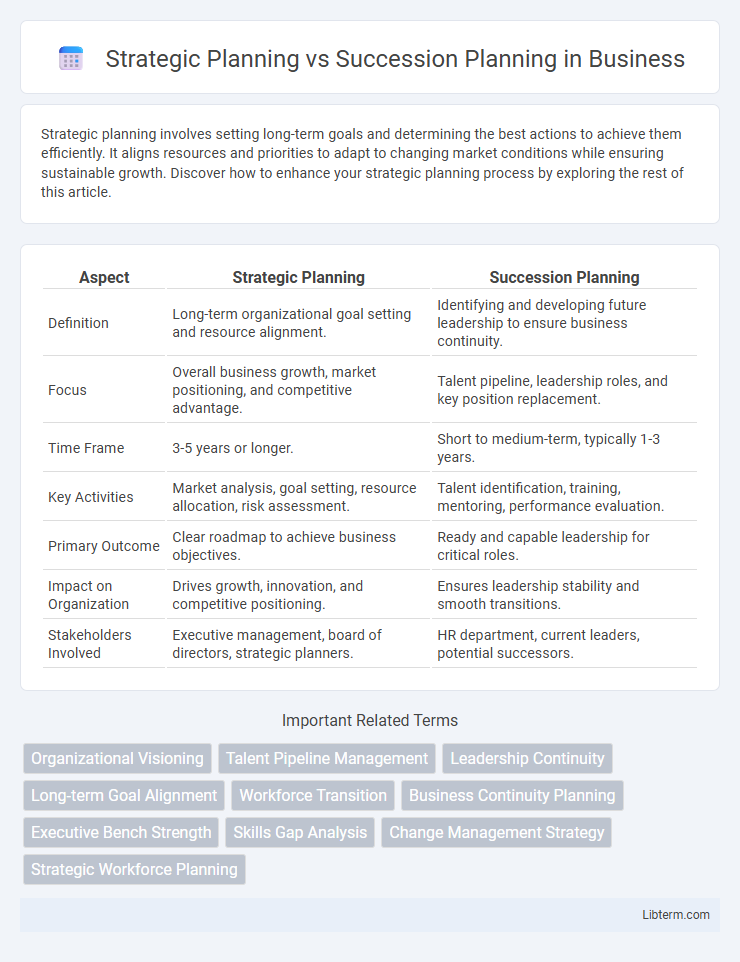Strategic planning involves setting long-term goals and determining the best actions to achieve them efficiently. It aligns resources and priorities to adapt to changing market conditions while ensuring sustainable growth. Discover how to enhance your strategic planning process by exploring the rest of this article.
Table of Comparison
| Aspect | Strategic Planning | Succession Planning |
|---|---|---|
| Definition | Long-term organizational goal setting and resource alignment. | Identifying and developing future leadership to ensure business continuity. |
| Focus | Overall business growth, market positioning, and competitive advantage. | Talent pipeline, leadership roles, and key position replacement. |
| Time Frame | 3-5 years or longer. | Short to medium-term, typically 1-3 years. |
| Key Activities | Market analysis, goal setting, resource allocation, risk assessment. | Talent identification, training, mentoring, performance evaluation. |
| Primary Outcome | Clear roadmap to achieve business objectives. | Ready and capable leadership for critical roles. |
| Impact on Organization | Drives growth, innovation, and competitive positioning. | Ensures leadership stability and smooth transitions. |
| Stakeholders Involved | Executive management, board of directors, strategic planners. | HR department, current leaders, potential successors. |
Understanding Strategic Planning: Definition and Scope
Strategic planning is a systematic process that defines an organization's long-term goals, allocates resources, and establishes actionable steps to achieve competitive advantage and sustainability. It encompasses environmental analysis, vision and mission formulation, goal setting, and performance monitoring to align all organizational functions toward common objectives. Organizations that excel in strategic planning can proactively adapt to market trends, customer needs, and technological advancements, ensuring resilience and growth.
What Is Succession Planning? An Overview
Succession planning is a strategic process that ensures the continuous leadership and critical role coverage within an organization by identifying and developing internal talent for future key positions. It focuses on preparing high-potential employees through targeted training, mentoring, and career development to mitigate risks associated with sudden departures or retirements. Unlike broader strategic planning, succession planning specifically targets talent pipelines to maintain organizational stability and long-term growth.
Key Objectives of Strategic Planning
Strategic planning focuses on defining organizational goals, aligning resources, and establishing actionable initiatives to achieve long-term competitive advantage and growth. Key objectives include market analysis, resource allocation, risk management, and performance measurement to ensure sustainable success. Unlike succession planning, which centers on leadership continuity, strategic planning provides a comprehensive roadmap for overall organizational development and adaptability.
Main Goals of Succession Planning
Succession planning primarily aims to identify and develop internal talent capable of filling key leadership roles to ensure organizational continuity and stability. It focuses on reducing risks associated with sudden vacancies, promoting employee retention, and aligning talent development with long-term business objectives. Effective succession planning strengthens leadership pipelines by preparing future executives through targeted training and career pathing strategies.
Differences Between Strategic and Succession Planning
Strategic planning focuses on defining an organization's long-term goals, resource allocation, and competitive positioning to ensure overall growth and sustainability. Succession planning specifically addresses identifying and developing internal talent to fill critical leadership roles, ensuring leadership continuity and minimizing disruption. The key difference lies in strategic planning's broad organizational scope versus succession planning's targeted approach to talent management and leadership transition.
The Importance of Aligning Both Planning Processes
Aligning strategic planning with succession planning ensures that leadership transitions support long-term organizational goals and maintain competitive advantage. Integrating these processes facilitates identifying and developing talent aligned with future business needs, reducing risks associated with leadership gaps. This alignment enhances organizational resilience by preparing a pipeline of capable leaders tailored to evolving strategic priorities.
Benefits of Integrating Strategic and Succession Planning
Integrating strategic planning with succession planning ensures leadership continuity aligned with long-term business goals, reducing risks associated with leadership gaps. This alignment enhances talent development by identifying and preparing future leaders whose skills match evolving organizational strategies. Organizations gain a competitive advantage through proactive workforce agility and sustained performance during transitions.
Common Challenges in Strategic and Succession Planning
Common challenges in strategic and succession planning include aligning organizational goals with available talent, managing resistance to change, and ensuring accurate forecasting of future leadership needs. Both processes require integrating comprehensive data analytics with human capital insights to mitigate risks related to skill gaps and leadership continuity. Overcoming communication barriers and fostering stakeholder engagement are critical for the successful implementation of strategic and succession initiatives.
Best Practices for Effective Planning Integration
Aligning strategic planning with succession planning requires identifying future leadership needs based on long-term business objectives and industry trends. Best practices include integrating talent development programs with organizational goals, regularly reviewing leadership pipelines, and using data-driven assessments to forecast skill gaps. Effective planning integration ensures seamless leadership transitions that support sustained competitive advantage and organizational resilience.
Future Trends in Organizational Planning Strategies
Future trends in organizational planning strategies highlight a growing integration of strategic planning with succession planning to create dynamic, adaptive frameworks that anticipate market disruptions and talent gaps. Advanced analytics and artificial intelligence are increasingly employed to forecast skill requirements and leadership potential, ensuring seamless transitions and sustained competitive advantage. Organizations are shifting towards continuous, data-driven planning cycles that align long-term business objectives with proactive leadership development and workforce agility.
Strategic Planning Infographic

 libterm.com
libterm.com